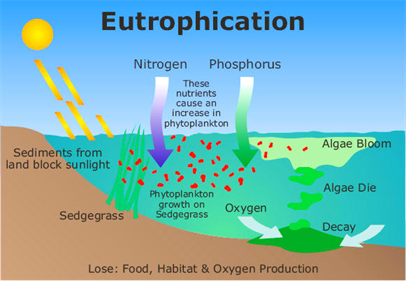
- Eutrophication is derived from the Greek word ‘eutrophos’ that means well-nourished or enriched
- Eutrophication is the excessive presence of nutrients like nitrate and phosphate in a lake or other water bodies, which causes a dense growth of plant life.
- Springs, streams, lakes are categorized as oligotrophic (poor nutrient content), mesotrophic (moderate nutrient content) and eutrophic (high nutrient content) on the basis of various contents like phosphorus, nitrogen and calcium.
Causes and Types of eutrophication:
- Natural causes (Natural eutrophication):
- This occurs because of the natural process of aging of lakes during which, nutrition status of water system gradually increases and oligotrophic lake is converted into a eutrophic lake.
- Similarly, death of aquatic plants and animals also increases nitrate and phosphate content of water.
- It permits the production of phytoplankton, algal blooms and aquatic vegetation (water hyacinth, aquatic weeds, water fern and water lettuce) that provide ample food for herbivorous zooplankton and fish.
- Man-made causes (Cultural eutrophication):
- This process is generally speeded up by human activities.
- They are responsible for the addition of 80% nitrogen and 75% phosphorus to lakes and streams.
- Use of NPK fertilizers, discharge of domestic and industrial wastes, detergents, urban drainage, animal wastes and sediments into water bodies leads to cultural eutrophication.
Effects of eutrophication:
- Eutrophication leads to various physical, chemical and biological changes in water deteriorating its quality.
- Enriched nitrogen and phosphorus content in water bodies facilitates heavy growth of aquatic plants like algae causing algal bloom which prevents penetration of light into deeper layer.

- Decomposition of algal bloom depletes the oxygen level and increases CO level in water. Due to this poor oxygen supply, aquatic organisms begin to die which turns the clean water into a stinking drain.
- Loss of dissolved oxygen results in anaerobic decomposition of organic matter that produces H2S, CH4, NH3 causing foul smell and putrefied taste of water.
- Algae, diatoms and rooted weeds show dominance by interfering hydroelectric power, clogging of water filters during water treatment process, retarding the water flow and affecting the quality of water and water works.
- Fatal water borne diseases such as polio, dysentery, diarrhea, typhoid and viral hepatitis spread as many pathogenic microbes, viruses, protozoans and bacteria grow on sewage products under anaerobic condition.
Controlling measures of eutrophication:
- Waste water like sewage must be properly treated before discharging it into water bodies.
- Algal blooms after death before further decomposition should be removed from water, which otherwise would further generate plant nutrients during decomposition.
- Use phosphate free detergents to reduce eutrophication.
- Growth of algae in water can also be controlled by applying algaecides such as CuSO4.
- Nitrate and phosphate should be removed from waste water before disposal into river, for which physico-chemical methods like precipitation, nitrification, denitrification, electro-dialysis, reverse osmosis and ion-exchange methods can be adopted.
- Prevent flooding of water from agricultural soil containing fertilizers to water system.
Eutrophication: Causes, Effects and Controlling measures